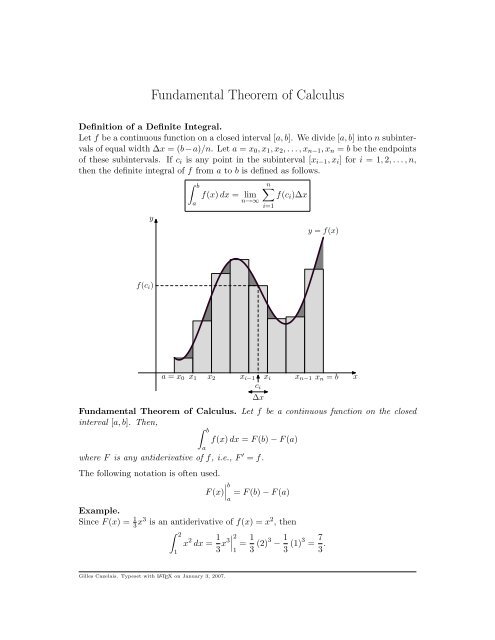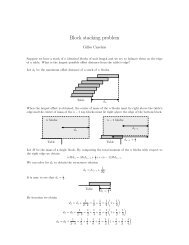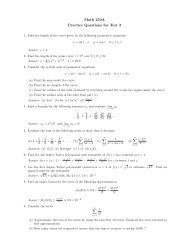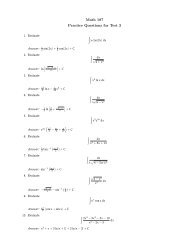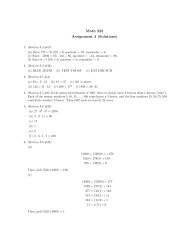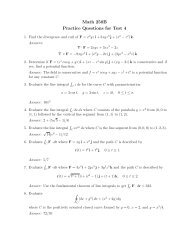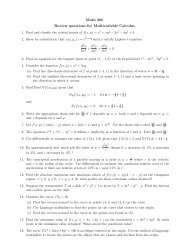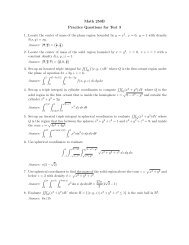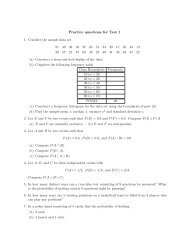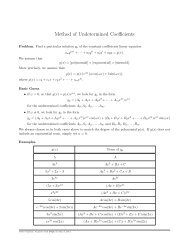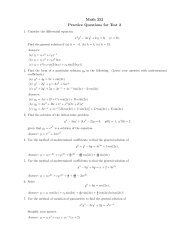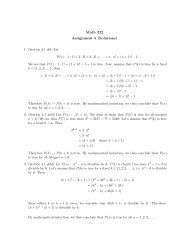Fundamental Theorem of Calculus
Fundamental Theorem of Calculus
Fundamental Theorem of Calculus
Create successful ePaper yourself
Turn your PDF publications into a flip-book with our unique Google optimized e-Paper software.
<strong>Fundamental</strong> <strong>Theorem</strong> <strong>of</strong> <strong>Calculus</strong><br />
Definition <strong>of</strong> a Definite Integral.<br />
Let f be a continuous function on a closed interval [a, b]. We divide [a, b] into n subintervals<br />
<strong>of</strong> equal width ∆x = (b−a)/n. Let a = x 0 , x 1 , x 2 , . . . , x n−1 , x n = b be the endpoints<br />
<strong>of</strong> these subintervals. If c i is any point in the subinterval [x i−1 , x i ] for i = 1, 2, . . . , n,<br />
then the definite integral <strong>of</strong> f from a to b is defined as follows.<br />
y<br />
∫ b<br />
a<br />
f(x) dx = lim<br />
n→∞<br />
n∑<br />
f(c i )∆x<br />
i=1<br />
y = f(x)<br />
f(c i )<br />
a = x 0 x 1 x 2 x i−1 x i x n−1 x n = b<br />
c i<br />
∆x<br />
<strong>Fundamental</strong> <strong>Theorem</strong> <strong>of</strong> <strong>Calculus</strong>. Let f be a continuous function on the closed<br />
interval [a, b]. Then,<br />
∫ b<br />
a<br />
f(x) dx = F (b) − F (a)<br />
where F is any antiderivative <strong>of</strong> f, i.e., F ′ = f.<br />
The following notation is <strong>of</strong>ten used.<br />
∣<br />
F (x)<br />
∣ b a<br />
= F (b) − F (a)<br />
Example.<br />
Since F (x) = 1 3 x3 is an antiderivative <strong>of</strong> f(x) = x 2 , then<br />
∫ 2<br />
1<br />
x 2 dx = 1 3 x3 ∣ ∣∣<br />
2<br />
1 = 1 3 (2)3 − 1 3 (1)3 = 7 3 .<br />
x<br />
Gilles Cazelais. Typeset with LATEX on January 3, 2007.
The pro<strong>of</strong> <strong>of</strong> the <strong>Fundamental</strong> <strong>Theorem</strong> <strong>of</strong> <strong>Calculus</strong> requires the Mean Value <strong>Theorem</strong>.<br />
Mean Value <strong>Theorem</strong>. If f is continuous on the closed interval [a, b] and differentiable<br />
on the open interval (a, b), then there exists a number c in (a, b) such that<br />
y<br />
f ′ (c) =<br />
f(b) − f(a)<br />
.<br />
b − a<br />
f(b)<br />
f(a)<br />
y = f(x)<br />
a<br />
c<br />
b<br />
x<br />
Let’s now prove the <strong>Fundamental</strong> <strong>Theorem</strong>.<br />
Pro<strong>of</strong>. Let f be a continuous function on the interval [a, b], and let F be an antiderivative<br />
<strong>of</strong> f. Let n be a positive integer and divide [a, b] into n subintervals <strong>of</strong> equal width<br />
∆x = (b − a)/n. Let x 0 = a, x 1 , x 2 , . . . , x n = b be the endpoints <strong>of</strong> these subintervals.<br />
Then,<br />
F (b) − F (a) = F (x n ) − F (x 0 )<br />
= F (x n ) + ( − F (x n−1 ) + F (x n−1 ) ) + · · · + ( − F (x 1 ) + F (x 1 ) ) − F (x 0 )<br />
= ( F (x n ) − F (x n−1 ) ) + · · · + ( F (x 1 ) − F (x 0 ) )<br />
n∑ (<br />
F (b) − F (a) = F (xi ) − F (x i−1 ) ) .<br />
i=1<br />
By the Mean Value <strong>Theorem</strong>, there exists a number c i in each subinterval [x i−1 , x i ] such<br />
that<br />
F ′ (c i ) = F (x i) − F (x i−1 )<br />
= F (x i) − F (x i−1 )<br />
.<br />
x i − x i−1 ∆x<br />
Then,<br />
F (x i ) − F (x i−1 ) = F ′ (c i )∆x.<br />
Since F is an antiderivative <strong>of</strong> f, we have F ′ (c i ) = f(c i ), therefore<br />
n∑<br />
F (b) − F (a) = f(c i )∆x.<br />
By taking the limit as n → ∞, we obtain<br />
F (b) − F (a) =<br />
i=1<br />
∫ b<br />
a<br />
f(x) dx.<br />
2


